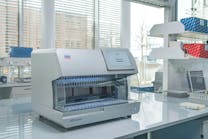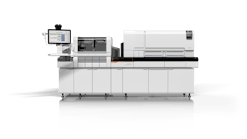Norman Sharples CEO,COPAN Diagnostics, Inc.
Professional:
Twenty-two years in the present position as
Co-Founder and CEO of COPAN.
Education:
John Moores University, Liverpool, UK
Graduate in Medical Laboratory Sciences; Masters, Clinical Bacteriology
Personal:
I am a passionate supporter of the Liverpool Football Club (LFC) and the English Premier League Football (AKA “soccer”). I like to exercise and stay fit with the occasional 5K themed races. At COPAN, we sponsor teambuilding activities, such as the Carlsbad 5000 race, mud runs, and a recently adopted annual bowling competition. Being from Liverpool, home of the Beatles, I have rock and roll in my blood and enjoy any live music events.
If you were explaining COPAN Diagnostics to someone who is not familiar with the organization, how would you characterize its primary areas of expertise? For someone who is not familiar with COPAN, I would start by describing our unique corporate culture. We strive to create an environment that fosters creativity and rewards innovation. We have a very strong culture and a low employee turnover. Being a family-owned company, we can make decisions based on our convictions and values, keeping in mind that, even though our products are used at the beginning of the diagnostics process, there is a patient at the end.
COPAN has two areas of expertise: sample collection and preservation for analysis, and automation. As for collection and preservation of biological samples, that applies to infectious disease diagnostics, human DNA, environmental testing, forensics investigations, and human genome typing. COPAN entered the automation arena in 2008. Since then, we have become a major player in the revolution of total automation in clinical microbiology, specifically sample processing, image analysis, and robotic work-up to improve efficiency, productivity, and turnaround time—and thus overall patient care.
Your website refers to the company’s “collaborative approach to innovation.” Can you explain that further? COPAN’s development of automated sample processors was done very collaboratively with the clinical microbiology community. We developed the prototype of the Specimen Processor, put it in the back of an RV, and drove it on a 35,000-mile roadshow all across North America to get feedback from microbiologists, lab managers, and bench techs. Before that, the WASP automation existed for specimen processing, but it was restrictive and would only process one sample type, namely urine. With our automation, we wanted a system that would be modular and open and could manage all sample types received in microbiology labs. This approach could only be successful in specimen collection and transport systems and by moving the sample into liquid phase.
The initial feedback that we received about the specimen processor raised excellent questions: Can the system prepare a Gram slide automatically? Can the system apply antibiogram and ID disks? Can the system plant and streak using different manufacturers’ plates? Can the system inoculate enrichment broths, among others? Because COPAN is nimble and creative, we were able to invent different modules to satisfy our customers’ requests.
The evolution of our specimen processor was a perfect example of collaborating with the microbiology community. Microbiologists want to invest in specimen processing automation and digital microbiology because they need to find a solution to replace the vanishing skilled workforce and the lack of new people entering the labor force. COPAN is a completely vertically integrated company, with all the skills and know-how in-house, so this allows us to bring new innovations and product improvements to market quickly.
There is a great deal of emphasis on specimen collection and transport nowadays, both in terms of sample integrity and lab efficiency. How do COPAN solutions address that need? Sometimes small inventions can have a big impact on diagnostics. The invention of flocked swabs by COPAN, more than 10 years ago, has revolutionized the quality of sample collection and transport because we were able to move away from traditional fiber-wrapped swabs that trapped more than 90 percent of the sample to flocked technology that releases most of the sample into liquid. The overall impact of this innovation was to increase sensitivity of different assays, amplified and not amplified. Virology laboratories embraced the innovation of flocked swabs because of the dramatic improvement of rapid detection of respiratory pathogens at the point of care and in the laboratory. The rapid migration to flocked swabs was very apparent in 2009, during the H1N1 pandemic, because flocked swabs provided a much easier sample collection alternative than nasopharyngeal aspirates or washes, with equivalent performance.
After the success and rapid adoption of flocked swabs in clinical Virology, the inventive devices caught the attention of Bacteriologists. From a bacteriology perspective, flocked swabs put high volume samples, like swabs, feces, and sputum, in a liquid format. Having the highest volume samples in liquid opened the door for automated specimen processing and digital Microbiology.
I understand that a large study recently affirmed WASPLab Software’s effectiveness in detecting MRSA on chromogenic agar. Can you expand on that? When labs invest in this technology, they are not doing so simply to automate manual processes. They are also bringing artificial intelligence to the Microbiology lab, because we have to have a medium- to long-term plan to replace the skills of trained Microbiologists that we are losing. We have to be able to digitally read and interpret specimen cultures. Artificial intelligence is achieved by amassing many algorithms that can be applied to a WASPLab 27 mega pixel image of a culture plate to look for specific organisms like MRSA, Vancomycin-resistant Enterococcus (VRE), or Group B strep, and also algorithms that can distinguish and segregate no-growth from normal flora from a significant growth of a presumptive pathogen.
WASPLab pixel-rich digital images captured by the system provide a sample size of at least 1,200 pixels per 1mm diameter colony. This is an enormous amount of data available per colony and the bigger the colony, the more data, which ensures a very accurate and reliable growth interpretation. The first in a wave of publications that demonstrate the accuracy and reliability of Copan WASPLab algorithms was a recent multi-center study published in the Journal of Clinical Microbiology on Copan’s MRSA reading algorithm. That publication has already been followed by a similar multicenter study that analyzed more than 100,000 patients on VRE.
Automation has come to Microbiology more slowly than it has to other benches. How did COPAN help make “the revolution” happen? It was slow to come because the biggest challenge was the variety and diversity of specimen containers received in the laboratory and sample viscosity, sometimes solid and sometimes semi-solid and sometimes liquid. COPAN, with its inventions in specimen collection and transport, moved all these sample types into standardized containers and liquid format. The standardization of the specimen container types facilitated the development of automation in specimen processing. So, Microbiology can now look more like a fully automated Chemistry laboratory. Laboratories can now truly move away from manual processing, and they can reallocate experienced staff to esoteric tasks that require their interpretational skill.
What are some trends you see for microbiology in the near future, and how is COPAN positioned to respond to them? The WASPLab algorithms are very exciting for Microbiology, and we are very honored to be part of this huge wave of change in the Microbiology. We have developed different algorithms that have been tested in different countries, with thousands of patient samples plated in different manufacturers’ media that were automatically scored by the algorithms to test for different pathogens, and the software never missed a positive. In fact, in some cases, it found positives that were missed by the manual inspections. I think Digital Microbiology will create a renaissance for chromogenic media and the development of new chromogenic media for targeted pathogens much in the same way we have developed molecular testing for specific organisms. In addition to algorithms for HAI surveillance cultures, we have algorithms for urine growth quantitation and segregation, on Blood and MacConkey, on whole and bi-plates. The strength of the algorithms will define the success of true Digital Microbiology in the clinical
laboratory.
Another trend that has emerged is the necessity to merge digital Gram slide images with culture plate images so both can be viewed on the same screen at the same time and can be stored and archived together as part of the patient record for retrospective analysis and for competency training and assessment. COPAN has pioneered the automation and interfacing of Gram slide image and culture plate images. In the past, without Digital Microbiology, the original specimen would be discarded in the trashcan. Now, it is preserved and can be accessed or shared if needed for virtual Grand Rounds!





